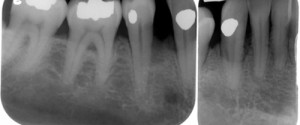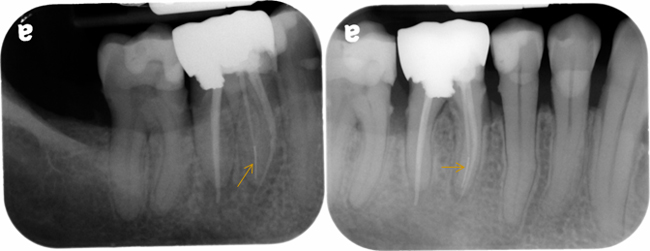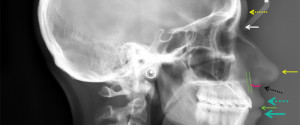Now onto the answers for the April 2014 Locate the Object. Here is image shift for both cases.
Image shift
Before starting to use the image shift principle it is important to know/remember two key points
- Images move in the opposite direction from the movement of the source.
- Images of objects farther from the image receptor will move more (aka objects (images) more facial/buccal will appear to move more).
 1) Pick a stationary object that is seen on both radiographs and appears to move in comparison to the metallic restoration on the canine = distal surface of the canine
1) Pick a stationary object that is seen on both radiographs and appears to move in comparison to the metallic restoration on the canine = distal surface of the canine
2) Determine the obvious angle change = horizontal angle. (Starting with the premolar periapical radiograph and moving to the canine/lateral incisor periapical radiograph, the source of radiation (tubehead) moves anteriorly/mesial decreasing the horizontal angle. According to point 1 above, this means the images move posterior/distal.)
3) Determine the image movement of the unknown object (metallic restoration on the canine) versus the stationary object (distal surface of the canine) = more posterior/distal (when moving from the premolar periapical to the canine/lateral incisor periapical radiograph).
4) The metallic restoration appears to be more posterior/distal on the radiograph meaning it is farther from the image receptor compared to the distal surface of the canine. This gives us an answer of the metallic restoration being on the buccal/facial surface of the canine.
1) Pick a stationary object that is seen on both radiographs and appears to move in comparison to the broken endodontic file in the first molar (orange arrow) = other endodontically treated mesial root of the first molar
2) Determine the obvious angle change = horizontal angle. (Starting with the molar periapical radiograph and moving to the premolar periapical radiograph, the source of radiation (tubehead) moves anteriorly/mesial decreasing the horizontal angle. According to point 1 above, this means the images move posterior/distal.)
3) Determine the image movement of the broken endodontic file (orange arrow) versus the other endodontically treated mesial root of the first molar = more anterior/mesial (when moving from the molar periapical to the premolar periapical radiograph).
4) The broken endodontic file (orange arrow) appears to move more anterior/mesial on the radiograph meaning it is closer from the image receptor compared to the other endodontically treated mesial root of the first molar. This gives us an answer of the broken endodontic file (orange arrow) being in the lingual root.
If you have any questions or comments, please leave them below. Thanks and enjoy!




